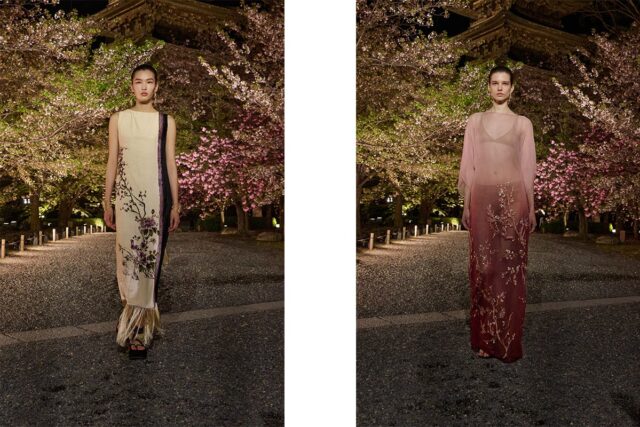Maria Grazia Chiuri has always been a storyteller. For Pre-Fall 2025, she brought Dior’s narrative to Kyoto, a city where the sacred meets the modern, where craft isn’t just respected, it’s revered. There, under the historic Tō-ji temple, a UNESCO World Heritage site etched in history since the 8th century, with cherry blossoms at their peak, the latest chapter in Dior’s story unfolded.
This wasn’t the Maison’s first brush with Japan. The House’s relationship with the country dates back to 1953, when Christian Dior not only imagined his iconic “Jardin Japonais” ensemble – a delicate dance of floral embroidery and silhouette – but also became the first haute couture House to show a collection in the country. A year later, he incorporated Kyoto’s famed Tatsumura textiles into his Autumn-Winter 1954 haute couture collection. Chiuri, ever the custodian of the House’s heritage, picked up these threads with thoughtful reverence, reinterpreting them for the now.
For Pre-Fall 2025, she turned to Kyoto’s master artisans to honour and revive those storied histories. From the Fukuda Dyeing and Embroidery Research Institute came steam-dyed landscapes, soft and dreamlike. From Tabata Kihachi, intricate yuzen prints scattered delicate sakura across silks. These were not simply decorative elements – they were layered, living expressions of place and tradition.
Jackets folded like origami. A crisp button-down with exaggerated cuffs peeked from beneath a kimono-shaped woven jacket, melding structure with softness. The motifs nodded to those once developed by Dior himself, reimagined here in silhouettes that felt both ancient and entirely modern.
But serenity was not the only note. Just as the collection lulled into a rhythm, a downtown Parisienne spirit broke through. Off-the-shoulder black knits, cropped bombers, a fur bolero that hugged the body like armour. A slouched, oversized charcoal denim set brought a new sense of cool to the artisanal offering. The Dior woman here wasn’t guarded as she’s sometimes been under Chiuri, but she was no less powerful.
French heritage and Japanese minimalism shared the same breath here, neither overpowering the other. And the backdrop of the Tō-ji, solemn and sublime, didn’t just serve as a setting; it became part of the narrative. There were no gimmicks or spectacles. Just a runway under the sakura, where past and present slipped easily into each other’s silhouettes. Dior, once again, found its future in remembering where it’s already been.
2025-04-16 07:00:00
#Dior #returns #Japan #PreFall #collection
Source link
















